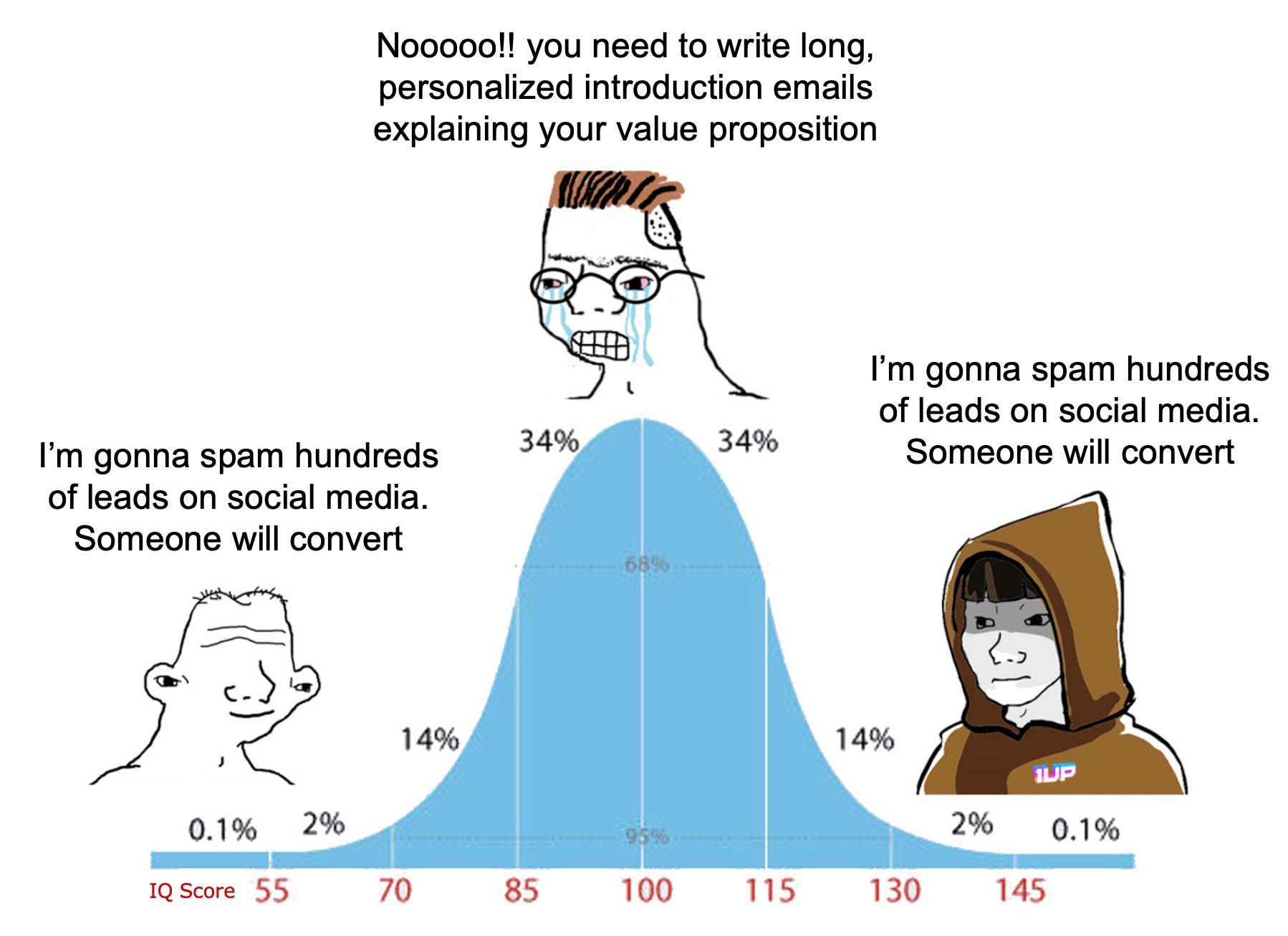Imagine if you could use GPT-3 for sales. Imagine leveraging AI technology to find better leads, improve sales communication, track everything in your pipeline, and close deals faster than ever.
I mean, short of a robot making cold calls for you, it’s gotta be a sales team’s dream, right?
Besides asking ChatGPT to turn your sales pitch into a rap, there are genuinely some amazing benefits of using AI in sales.
And it’s nothing new, either. Sales and AI have been working together quietly for decades.
Decades?
YES, decades.
Since the first computer systems became involved in sales pipelines, we have had computers helping us move deals through the funnel while providing us the data to drive sales forward.
So what is new?
Recent advancements in AI technology like GPT-3 means Sales teams will be able to automate, scale, analyze and improve more stages of sales than ever before.
How Can AI Help With Sales?

At this point, a lot of AI may seem abstract – particularly in the traditionally human-led business development and sales arena. Selling is very emotional and personal and is about listening to a prospect’s problems and pains and displaying value through your product. It’s also a bit of an art form. Anybody can read a sales call script, but they’ll sound like robots. It takes a particular skill set and mindset not only to sell, but to sell well. An emotional intelligence, if you will.
So while AI will never be a sales rep (OK, never is admittedly a strong word) it can massively help with the sales process. Let’s look at some steps in the sales funnel and see how AI can help strengthen the process and workflows.
How Can AI Help With List Building?
Data is a sticky point in sales. They say a bad salesperson blames the data, but… bad data can genuinely make selling REALLY tricky.

Sales teams can either go out and source their own data, purchase dataa, or even have marketing drive warm inbound leads to their desks. Each method has pros and cons.
In the first instance, getting your own data can be tricky. See, data used to take a LOT of time to put together, and companies would be protective of it. In fact, directories used to seed fake listings within their data to catch out cheeky sales reps. If you tried to cold call from a Yellow Pages and found one of their sneaky seeded adverts, BOOM, instant fine to your business.
Getting data is easier now. There are sites like Apollo.io where you can create and build lists of leads and use AI to help segment and find the most likely to be interested in your product.
GPT-3 can be used to create super accurate lead scoring models. This way, programs can identify the best prospects from a data pool. This means more accurate leads for sales teams and less time wasted chasing time wasters and non-relevant companies. Imagine never having to qualify a lead ever again. Total bliss.

Another way AI can help you in the first instance is to read the news and markets and forecast when a company is ready to be contacted. AI tracks things like social media activity, share prices and general info to help alert sales teams when new opportunities arise. This is already the case for Apollo.io, where you can select lists of companies looking to purchase and invest in different areas.
AI can act as your eyes on the market. Except it’s better than your own eyes, because it’s monitoring the market 24/7, always on the ball and ready to jump on an opportunity.
AI can also cleanse and weed out irrelevant contacts, even if data is purchased for you or generated using marketing. So when a warm lead comes in, AI can be trained to search and qualify the lead before it ends up on someone’s calendar.
How Can AI Help With Outreach & First Contact?
So, let’s say you have a company to sell to, and the name of the decision maker to contact. How on earth do you approach them? Do you email? Call? Send a carrier pigeon?
GPT-3 and other AI technologies can help you in this area by automating processes.
AI can scan emails and other communication from similar companies you’ve been in touch with to forecast who is most likely to respond well, what kind of language they use, when they are likely to be available – or even what kind of messaging gets the best responses.
This kind of fast analysis is essential for finetuning your outreach methods.

Then you can use an AI writer such as HoppyCopy or Copy.ai to craft the perfect cold email or cold calling script. The AI writer can tailor the language to individualize and focus on the specifics of your customer, making sure that no one gets a copy-and-paste message.
Also, as the AI learns your tone of voice, it will adapt and get smarter. It can even keep scanning all those social media channels and come up with suggestions for personalization or even A/B testing with subject lines.
Using it in your cold outreach process makes it…well, not so cold anymore.
There will be no need to contact thousands of prospects manually. There will be no need to waste your sales team’s time, nor the recipients’. With smarter, data-driven messaging sent at the right time to the right people, you can send fewer emails yet generate more leads.
How Can AI Help With Sales Calls & Meetings?
Here’s where AI can really help: supercharging sales is in communication with potential customers. Telephone and email are great, but video calling has made sales so much more personalized.
There’s this old adage “people buy from people”. In the days of field sales, driving around the country, and visiting customers face-to-face, it was easy to build rapport and relationships. You could speak to someone, read their body language, make a joke, and look for subtle signals that someone was ready to buy or perhaps needed more convincing.
This element was certainly lost as sales then moved digitally to telephone call centers and email. Getting out and about cost gas money, took a lot of time and had no guarantees. Why send someone out for a day to make four appointments when they could sit and make 300 phone calls or send 500 emails?
Then video calling became normalized. People were pushed out of their comfort zone and onto Zoom and Google Meet calls. The facial expressions, the rapport building, and the “people buying from people” returned. And while that was amazing, this modern equivalent also brought a superpower.
Recording.
Or, more specifically, sales call recording software.

By using an AI meeting tool to record meetings, sales teams now have all that important information, insights, buying signals, and the “golden nuggets” that will help them get a deal across the line. This can be viewed multiple times by the rep, shared with their management, or even shared across the broader team for feedback.
It also signaled the beginning of async sales calls. If a key decision maker can’t make a demonstration call, they can be brought up to speed using video highlights. There’s no need to have multiple calls with different departments. Everything can be done quickly and in one go.
Tools like tl;dv make it so easy to revisit calls, refresh the key points, and pass prospects to others so they can be followed up. There’s a physical record of who said what, where, when, and why. No more bickering over who sold what and who got the buy-in – the receipts are all there. Plus, clips from high-performing sales reps can be used to train new recruites. More time saved all around!

The automation of AI calls means no more long hours trying to sift through emails and call recordings. Call transcripts can be tagged manually; you can search through the library of calls for a particular keyword or tag the call as you go. This means you can always find exactly what you are looking for.
And, what’s even better tl;dv can integrate directly with CRM systems like HubSpot and SalesForce, pulling all that valuable data into a permanent shareable place to keep it safe.
How Can AI Help With Closing The Sale?
All that information is great, but how can AI help those leads become customers?
One of its key advantages is AI’s ability to analyze data and automate mundane tasks quickly. As technology moves forward and artificial intelligence in sales becomes more widespread, the data that drives it will grow and grow.
To close the sale, you need to be confident and be able to get the prospect to be happy to go ahead. Every question needs to be answered, you need to have flushed out all the objections, and they need to feel at ease with you and the product.
Using lead scoring systems like those from places like Objective IT and H20.ai means you’ll know when the time is right to go for the close. Like in computer games when the haptic controller buzzes as you get close to the objective, AI can send emails and prompts in real-time that will help you to close.

What’s more, you can even share your demos and sales calls with your prospects. Meeting recorders like tl;dv can be used to create a highlight reel of the product offering benefits (which you can then send to your prospect, reminding them of the value!)
The minute your prospect views that recording, you will know that you are on their mind. Surely that’s the perfect time to shoot them a “well-timed” follow-up email?
How Can AI Help With Training & Development?
One of the things about being a salesperson is that you need to keep developing your skills. Every good manager will send links to Ted Talks about goal setting and leave copies of Atomic Habits on your desk, encouraging you to do more self-development.
Listening to calls has always been a key part of a salesperson’s training. Listening to good and bad calls, critiquing, and finding out what they could have done better.
We are now in an age where that process is no longer laborious. With tools like tl;dv, you can quickly search and filter through recordings for keywords, topics or behaviors. You can tag the calls so you know which ones your salespeople have already listened to. And you can showcase the great calls, highlight good practices, and share them with the rest of the team.
AI can also help to track success rates. By measuring and tracking progress over time, you can gain insights into which techniques work best, where reps may need more training, and where they excel in their field. This constant development and striving for more means that sales teams can win more clients in less time.
The Future of Sales & AI
AI is the future of sales and really is here to stay. This should mean that sales should get easier. (SHOULD! Could you not hold us to that!?)
On the nuts and bolts of it, AI will allow salespeople to focus on the people side of sales. At the same time, technology does the heavy lifting in terms of data entry and analysis.
With more automated processes, businesses have less overhead, allowing them to make better decisions about how to allocate resources and offer better incentives. And while we’re not quite at the stage where robots will be doing all the work, AI is certainly making its mark in sales and helping reps to close more deals faster.
In ChatGPT’s own words:
"...sales is a complex and relationship-driven field that requires empathy, creativity, and problem-solving skills. AI may be able to assist with these tasks, but it's unlikely that it will be able to fully replicate the nuanced human interactions that are so important to successful sales."
ChatGPT Tweet
See, even Chat GPT agrees. So embrace the change and get on the AI and sales love-in by test driving tl;dv for free today.





